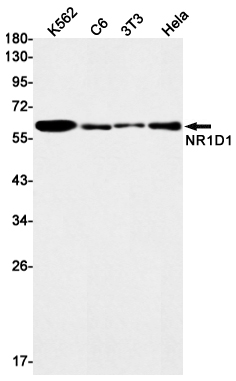Product Detail
Product NameNR1D1 Rabbit mAb
Clone No.S05-8B1
Host SpeciesRecombinant Rabbit
ClonalityMonoclonal
IsotypeRabbit IgG
PurificationAffinity Purified
ApplicationsWB IF
Species ReactivityHuman,Mouse,Rat
Immunogen DescA synthetic peptide of human NR1D1
ConjugateUnconjugated
Other NamesEAR1; hRev; THRA1; THRAL; ear-1; REVERBA; REVERBalpha
Accession NoSwiss-Prot:P20393
GeneID:9572
Uniprot
P20393
Gene ID
9572
Calculated MWCalculated MW: 67 kDa; Observed MW: 67 kDa
Concentration0.3 mg/ml
Formulation50mM Tris-Glycine(pH 7.4), 0.15M NaCl, 40% Glycerol, 0.01% Sodium azide and 0.05% BSA
StorageStore at 4˚C short term. Aliquot and store at -20˚C long term. Avoid freeze/thaw cycles.
Application Details
WB: 1/1000; ICC/IF: 1/20;
Western blot detection of NR1D1 in K562,C6,3T3,Hela cell lysates using NR1D1 Rabbit mAb(1:1000 diluted).Predicted band size:67kDa.Observed band size:67kDa.
Immunofluorescence of NR1D1(green) in Hela cells using NR1D1 Rabbit mAb at dilution 1/50, and DAPI(blue)
Swiss-Prot Acc.P20393.Transcriptional repressor which coordinates circadian rhythm and metabolic pathways in a heme-dependent manner. Integral component of the complex transcription machinery that governs circadian rhythmicity and forms a critical negative limb of the circadian clock by directly repressing the expression of core clock components ARTNL/BMAL1, CLOCK and CRY1. Also regulates genes involved in metabolic functions, including lipid and bile acid metabolism, adipogenesis, gluconeogenesis and the macrophage inflammatory response. Acts as a receptor for heme which stimulates its interaction with the NCOR1/HDAC3 corepressor complex, enhancing transcriptional repression. Recognizes two classes of DNA response elements within the promoter of its target genes and can bind to DNA as either monomers or homodimers, depending on the nature of the response element. Binds as a monomer to a response element composed of the consensus half-site motif 5'-[A/G]GGTCA-3' preceded by an A/T-rich 5' sequence (RevRE), or as a homodimer to a direct repeat of the core motif spaced by two nucleotides (RevDR-2). Acts as a potent competitive repressor of ROR alpha (RORA) function and regulates the levels of its ligand heme by repressing the expression of PPARGC1A, a potent inducer of heme synthesis. Regulates lipid metabolism by repressing the expression of APOC3 and by influencing the activity of sterol response element binding proteins (SREBPs); represses INSIG2 which interferes with the proteolytic activation of SREBPs which in turn govern the rhythmic expression of enzymes with key functions in sterol and fatty acid synthesis. Regulates gluconeogenesis via repression of G6PC and PEPCK and adipocyte differentiation via repression of PPARG. Regulates glucagon release in pancreatic alpha-cells via the AMPK-NAMPT-SIRT1 pathway and the proliferation, glucose-induced insulin secretion and expression of key lipogenic genes in pancreatic-beta cells. Positively regulates bile acid synthesis by increasing hepatic expression of CYP7A1 via repression of NR0B2 and NFIL3 which are negative regulators of CYP7A1. Modulates skeletal muscle oxidative capacity by regulating mitochondrial biogenesis and autophagy; controls mitochondrial biogenesis and respiration by interfering with the STK11-PRKAA1/2-SIRT1-PPARGC1A signaling pathway. Represses the expression of SERPINE1/PAI1, an important modulator of cardiovascular disease and the expression of inflammatory cytokines and chemokines in macrophages. Represses gene expression at a distance in macrophages by inhibiting the transcription of enhancer-derived RNAs (eRNAs). Plays a role in the circadian regulation of body temperature and negatively regulates thermogenic transcriptional programs in brown adipose tissue (BAT); imposes a circadian oscillation in BAT activity, increasing body temperature when awake and depressing thermogenesis during sleep. In concert with NR2E3, regulates transcriptional networks critical for photoreceptor development and function. In addition to its activity as a repressor, can also act as a transcriptional activator. In the ovarian granulosa cells acts as a transcriptional activator of STAR which plays a role in steroid biosynthesis. In collaboration with SP1, activates GJA1 transcription in a heme-independent manner.
If you have published an article using product 52470, please notify us so that we can cite your literature.




 Yes
Yes



